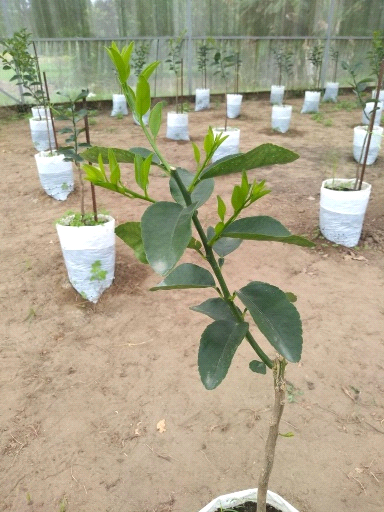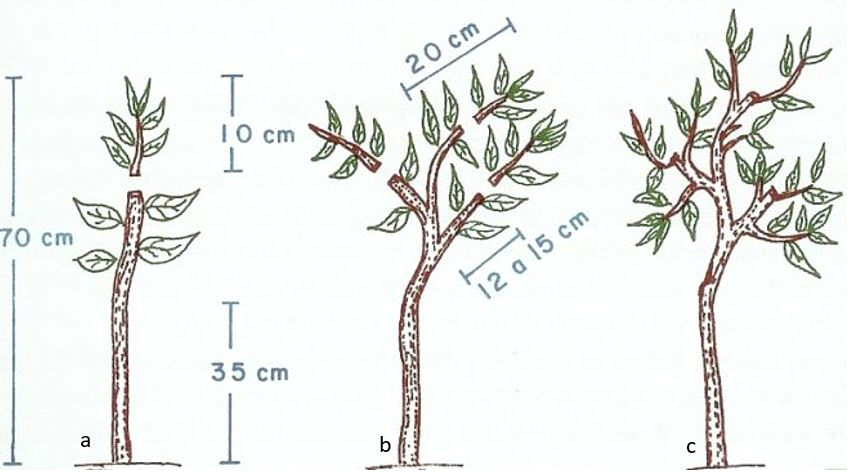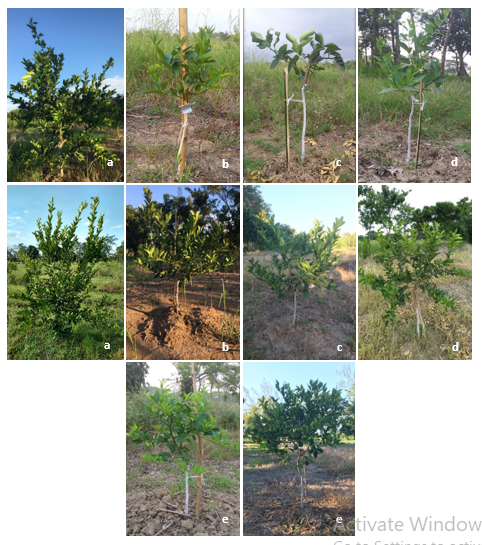Open Access Journal of
eISSN: 2575-9086


Research Article Volume 8 Issue 1
1National Institute of Forestry, Agriculture and Livestock Research (INIFAP-CIRGOC), Mexico
2Popular University of the Chontalpa, Mexico
Correspondence: Pablo Ulises Hernández Lara, National Institute of Forestry, Agriculture and Livestock Research (INIFAP-CIRGOC), Mexico
Received: January 03, 2025 | Published: January 23, 2025
Citation: Lara PUH,Velázquez SS, López DRR. Formation pruning in Persian lemon plants during the establishment stage. Open Access J Sci. 2025;8(1):10-13. DOI: 10.15406/oajs.2025.08.00239
The agronomic management of the Persian lemon crop in the region of Huimanguillo, Tabasco, presents limitations that are manifested from the establishment of the plantation, such as the inadequate formation of the trees in the implantation stage. The objective of the study was to evaluate the response of formation pruning (FP) in young plants of Persian lemon (Citrus latifolia Tanaka), accompanied by agronomic practices in a commercial plantation of eight months of age grafted on sour orange. The research was conducted from March to December 2021 in Ejido Libertad Agraria, Municipality of Huimanguillo, Tabasco, Mexico. Classical statistics were used to describe the behavior of rootstock trunk diameter, Persian lemon trunk diameter, the relationship between both trunks, as trunk response variables, and total height, lower height, real height and crown diameter, as crown response variables. A completely randomized design with five treatments was established. Two rows with 30 Persian lemon trees each were used, where each tree was an experimental unit. The treatments were: (T1) control or natural growth, (T2) pruning, (T3) pruning+pruning, (T4) pruning+pruning+fertilization and (T5) pruning+pruning+fertilization+bio-stimulation. T4 developed the largest rootstock trunk diameter (4.75 cm), expressed the best vegetative growth and development in the formation of well-distributed branches and outperformed the rest of the treatments evaluated. T4 developed the largest Persian Lemon Stem Diameter (SLD) (4.73 cm), compared to the other treatments. T3 and T4 shared the best trunk ratio compatibility. From the present study, it was possible to suggest agronomic management recommendations applicable to the needs and resources of growers in the region, such as adequate pruning at planting time, soil ridging to improve aeration and nutrient absorption, and fractional fertilization.
Keywords: shoot, structure, budding, agronomic management, shoot growth, agronomic management
SLD, lemon stem diameter; DTP, diameter of rootstock trunk; DTLP, diameter of Persian lemon trunk; TCH, total crown height; ARC, actual crown height; DC, crown diameter
Persian lemons are one of Mexico's main exports. The main Persian lemon growing region in Tabasco is the region corresponding to the Huimanguillo savanna, where the soils are clay-textured, very acidic and often contain more than 40% exchangeable aluminum,1 which causes iron chlorosis and magnesium deficiencies. For the year 2021 in the state of Tabasco, the planted area was 7,227.32 ha. The municipality of Huimanguillo sows 97% of the total area, being the main producer of this fruit tree in the state with 7,015 ha sown, from which an average yield of 12.09 t per ha is obtained.2 Agronomic management in the cultivation of Persian lemons presents limitations from the moment the plantation is established and during its life cycle, such as land preparation, planting orientation, lack of knowledge in fertilization, poor rootstock selection, inadequate control of pests and diseases, as well as poor tree formation during the establishment stage. During the establishment stage, the need for pruning arises because some of the factors that favor the expression of the crop's productive potential are adequate plant structure and lighting. Adequate FP provides the tree with an ideal structure with the purpose of forming a strong and vigorous framework or skeleton, capable of withstanding mechanical damage by the action of the practices developed, air currents, as well as by the weight of the branches and fruits in future harvests.3,4 Most Persian lemon growers in the region do not carry out this practice, and in those who do, there is a lack of knowledge about how much, when and how to prune. Therefore, the objective of the present research was to evaluate the response of FP accompanied by agronomic practices in young plants of Persian lime (Citrus latifolia T.) grafted on sour orange.
Description of the study area and period
The research was conducted from March to December 2021 in the Ejido Libertad Agraria, Municipality of Huimanguillo, Tabasco, in a commercial plantation of Persian lime eight months old, with a planting frame of 6.0 m x 5.5 m (303 trees per hectare), at the GPS coordinates: latitude 17° 39'26¨ N and longitude 93° 24'22¨ W taken by the geographic information system Google Earth, with an altitude of 35 m asl. This area, as in most of the territory of the entity (95%), has a warm humid climate with abundant rainfall in summer (Am). The maximum temperature is recorded before the rainy season and the summer solstice (May) with an average value of 36°C, reaching 42°C as the hottest record, and the minimum is 18.5°C in January.5
Plantation management
Agronomic management of the orchard was carried out by the cooperating producer. The activities are described below: a) weed management in March, May, July, September, November and December, with a brush cutter and manual machete trimming. b) pest management: control of leafminer, red spider mite, black fly, diaphorine and aphid in April, May, June, August, October, November and December, with paraffinic oil/emulsifiable concentrate and commercial liquid soap at 2% for both products. Likewise, (E)-1-(6-Chloro-3-Pyridylmethyl)-N-nitroimidazolidin-2-ylidenamine at 0.3% and Streptomyces avermitilis formulated as emulsifiable concentrate at 3% were applied as reinforcement for the control of sucking insects. c) auxiliary irrigation provided every 15 days during the months of April, May, June and August, being the hottest months and with low soil humidity. The water applied was 20 to 30 L of water per plant, and d) for treatments other than the control, suckers, also called "suckers" or "cuchos" from the rootstock were eliminated each time they emerged and pruning covers were applied immediately to prevent the entry of pathogens.
Description of the training pruning practice
FP is an indispensable task in the agronomic management of Persian lemon cultivation, which is suggested to be carried out at the moment of plant establishment in the definitive field, or even when the plant is in the nursery (Figure 1). The FP in the establishment stage should be light and at the pace required by the tree, because if an aggressive and constant pruning is done, what is achieved is a lot of growth of shoots, which are weak, as well as shoots that come out of the same point of the stem, which slows the growth and future entry into production. Due to the physiological imbalance generated by inadequate pruning, the tree can die.6 FP was carried out according to Curti Díaz et al.,7 and consisted of a 10 cm pruning of the main stem of the tree in order to break the apical dominance and thus stimulate lateral bud break (Figure 2a). From the buds formed, three or four are selected and distributed around the stem, which will become the primary branches that will initiate the formation of the skeleton of the tree. If more than one shoot emerges at the same point on the stem, the most vigorous or the one in the best position should be selected and the rest of them eliminated. When the primary branches reach 20 cm in length, a second five to seven centimeter shoot removal is performed to break the apical dominance again and thus stimulate lateral bud break once more (Figure 2b). From the new shoots, two or three are selected and distributed around each primary branch. If more than one bud emerges at the same point on the primary branch, the most vigorous or the one in the best position is selected and the rest of them are eliminated. At the end, the tree will have between eight and 12 well-distributed branches and an excellent crown formation (Figure 2c).6

Figure 1 Recommended training pruning from the plant production stage (nursery). Credits: Hernández Lara.

Figure 2 Necessary cuttings that reflect an adequate formation pruning. a). First pruning of 10 cm to the main stem, b). Second trimming of five to seven cm to the three or four primary branches selected, c). Selection of two to three shoots distributed around each primary branch. Credits: Curti Diaz.
Description of agronomic practices
In this study, the FP practice was carried out at the beginning of the experiment. With the support of an acorn pruning shear, the first pruning was performed. When moving from one tree to another, the tool was disinfected with a 5% sodium hypochlorite-based commercial solution to prevent the transmission of pathogens. Hilling was done with a hoe at a distance of 1.20 m from the stem of the plant at a depth of five cm and the soil was incorporated in favor of the plant. Fertilization was carried out with the 12-61-00 mixture (nitrogen and phosphorus). Depending on the age of the trees, 43 g of the mixture per plant were applied to the bottom of the soil in the drip area.7 Likewise, the biostimulant Maxi-Grow Excel was applied to promote vegetative growth at a dose of 2 mL per L of water.
Response variables
Data on trunk and crown dimensions of Persian lemon trees were recorded at the beginning and end of the experiment, March and December 2021, respectively. Both measurements were compared between the same treatments.8 Other variables were temperature and relative humidity.
Trunk dimensions
a). Diameter of rootstock trunk (DTP) (cm) and diameter of Persian lemon trunk (DTLP) (cm). The circumference of each trunk, measured at 10 cm distance from the rootstock/rootstock union, was divided by the value of Pi (3.1416), and expressed in centimeters; b). Ratio of the rootstock trunk compared to the Persian lemon trunk. To determine the development ratio of both trunks, the DTP was divided by the DTLP, and expressed in centimeters.
Cup dimensions
a). Total crown height (TCH) (cm). The CTA was measured from the base of the stem to the ground to where the highest branch of the tree ends. b). Lower crown height (AIC) (cm). The AIC was measured from the base of the stem to the ground to where the first lower branch of the tree begins. c). Actual crown height (ARC) (cm). d). Diameter of the crown (DC) (cm). It was obtained by averaging the diameter of the tree crown (cm) recorded in two directions (N-S and E-W), measured at 1 m above the ground in the densest part of the foliage and following the normal shape of the crown, i.e., without considering the long branches that protrude from it.9
Experimental design
Two rows with 30 Persian lemon trees each were used. A randomized block design was established with five treatments (agronomic practices) including the control and 12 replicates for each treatment (Table 1). A total of 60 experimental units were obtained where each tree was an experimental unit. The recorded data were analyzed with the Statistical Analysis System program (Anonymous, 2010), version 9.2. For the separation of means, the Tukey test was used with an error probability of 5%.
|
No. of Treatments |
Experimental units |
Description |
|
T1 |
12 |
Witness or natural growth |
|
T2 |
12 |
Pruning |
|
T3 |
12 |
Pruning + Plowing |
|
T4 |
12 |
Pruning + fertilization |
|
T5 |
12 |
Pruning + fertilization + biostimulation + fertilization + biostimulation |
Table 1 Treatments to be evaluated, experimental units and description of each treatment
Stem dimensions
T4 was the one that developed the largest rootstock trunk diameter (DTP) with 4.75 cm, and surpassed the rest of the treatments evaluated (Table 2), which coincides with the superior vigor visually observed in the field due to the acceptable compatibility between rootstock-rootstock union between species, which allows excellent agronomic management and a long productive life.10 While treatments T2, T3 and T5 showed intermediate values of DTP with 4.32 cm on average; finally T1 showed the lowest DTP with 3.32 cm, which, is deduced by the sequestration of nutrients caused by the suckers that are born from the base of the rootstock trunk and which in turn causes the increase in the vigor of the same. The agricultural practice of pruning plus hilling plus fertilization (T4) developed the largest trunk diameter of Persian lemon (DTLP) with 4.73 cm. Treatments T2 and T5 showed intermediate DTLP growth with 4.30 cm on average; while treatments T1 and T3 showed the lowest values in their diameters with 3.27 and 4.07 cm respectively.
|
Treatments |
Trunk dimensions (cm) |
DTP vs DTLP relationship (compatibility) |
|
|
DTP |
DTLP |
||
|
T1 |
3.32 ª |
3.27 ª |
1.01 ª |
|
T2 |
4.46 ª |
4.26 ª |
1.04 b |
|
T3 |
4.11 ª |
4.07 ª |
1.00 ª |
|
T4 |
4.75 b |
4.73 b |
1.00 ª |
|
T5 |
4.40 ª |
4.35 ª |
1.01 ª |
|
AVERAGE |
4.126 |
4.218 |
1.003 |
|
DMS |
1.256 |
1.86 |
0.171 |
|
CV (%) |
2.405 |
6.61 |
22.312 |
Table 2 Influence of the dimensions of the rootstock trunk, Persian lemon trunk and relationship between both parts of the tree at the end of the experiment (December 2021) in an eight-month-old commercial plantation in Huimanguillo, Tabasco
Means with the same letter, within columns, are equal according to the Tukey test at P ≤ 0.05%. DTP: rootstock trunk diameter; DTLP: Persian lemon trunk diameter.
The development over time was compared and a significant increase was observed in relation to the agricultural practices applied for all treatments, highlighting the best result in T4. It is important to mention that in all treatments, dividing the DTP by the DTLP gave values close to one, a characteristic associated with good compatibility between both parts of the tree.11,12
Cup dimensions
The highest actual crown height (ARC) of the Persian lemon tree was generated by T1 (308 cm), which significantly exceeded the crown height of the other treatments, a result that agrees with what was indicated by Curti-Díaz et al.,7 on the capacity of trees that are allowed to grow naturally without applying pruning practices at opportune times. Likewise, the crown diameter (DC) of T1 (151 cm) exceeded treatments T2, T3, T4 and T5 with 67, 82.5, 50.5 and 70.5 cm respectively. This was due to the fact that it grew naturally without intervention from the training pruning practice. The crown diameter DC of T4 was greater than 100 cm, which reflects a positive influence when compared with the dimensions of the rootstock trunk and the Persian lemon trunk. The smallest crown diameter DC was generated by T3. Of the five treatments evaluated, T4, which corresponds to the practice of pruning plus hilling plus fertilization, was the one that showed better growth and vigor in the formation of well-distributed branches, as well as faster growth and development compared to the other treatments (Figure 3).

Figure 3 Growth and development of Persian lemon plants and their relationship with treatments. a) Control or natural growth (T1). b) Pruning (T2). c) Pruning plus hilling (T3). d) Pruning plus hilling plus fertilization (T4). e) Pruning plus hilling plus fertilization plus biostimulation (T5).
Temperatures and relative humidity during the experiment
During the period evaluated, the average temperature recorded was 26°C as minimum and 36°C as maximum, with April and May being the hottest months with records above 40°C. Likewise, the average relative humidity recorded during the morning, midday and night was 83%, 54% and 77% respectively. Temperature in Persian lemon cultivation is an important factor since it influences vegetative growth and the production or development of the fruit.13 It is important to mention that during the time of the experiment, temperatures behaved within the acceptable range required by Persian lemon cultivation. Likewise, high relative humidity of 80% to 90% is an advantage for the growth and development of citrus, since it decreases the transpiration rate and water consumption is lower compared to areas with low relative humidity.
When PF is applied correctly, important benefits are achieved, such as: controlling the shape and size of the tree, distributing the main branches, promoting flowering and fruiting, improving production in the plant, improving light distribution in the tree canopy, accelerating the entry into production, facilitating and making efficient the spraying of phytosanitary products and nutrients to the foliage, facilitating harvesting and providing mechanical strength to the tree, among others. With the present study, it was possible to suggest agronomic management recommendations applicable to the needs and resources of the region's producers, such as adequate formative pruning at the time of planting, hilling of the soil to improve aeration and nutrient absorption, and fractional fertilization.
None.
The author declares there is no conflict of interest.

©2025 Lara, et al. This is an open access article distributed under the terms of the, which permits unrestricted use, distribution, and build upon your work non-commercially.